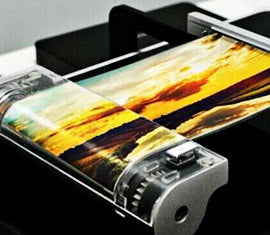A good mobile phone repair kit will contain a selection of different screwdrivers of different types and sizes. Most mobile phone screws are either 'Phillips' (that is their head is a cross-shape) or 'Pentalobe' (for which the head is a five-pointed star). If the kit is required for a particular model of phone, then it's a good idea to research the kind of screws it contains before getting a kit to ensure the correct screwdrivers are included. One useful feature on the more expensive screwdrivers is a built-in light. This can make it much easier to see inside the phone.

Opening Tool
There are lots of tools available specifically designed for opening mobile phones. It's not a good idea to use any kind of metal implement for this purpose (for example, don't be tempted to use a screwdriver), so most of them are made out of some form of plastic. One popular design is the shape of a guitar plectrum, but others are more stick-like. It's a matter of personal preference which to choose, and as they are inexpensive, a kit including several different types is often a good option.

Tweezers
Tweezers are extremely useful for getting to the smallest parts within a mobile phone. Models with very thin, needle-like ends are the most useful, and many phone repairers prefer elbow tweezers, which have a bend in them.
Scratch Tool
A scratch tool, similar to those used by dentists, can come in very handy for removing small quantities of adhesive, or moving small parts around.

Suction Cup or Pump
A suction cup can be used to remove screens from mobile phones without damaging them. It's not a good idea to use any kind of suction device not specifically designed for this purpose, as they may not be strong enough, and there will be a risk of the screen breaking.

Instructions
It's important not to try to repair a mobile phone without a good knowledge of what needs to be done. Some repair kits come complete with instructions, but if one that doesn't has been chosen, or if someone is assembling a kit from scratch, there is no need to buy any instructions as there is plenty available on the internet. It's a good idea to be prepared in advance, however, especially for people who often have to rely on their mobile phone for internet access, for example when travelling. Consider printing out instructions for the most common types of repair, remembering to check they're for exactly the right model of phone.
Drying Pouch
One particularly difficult form of mobile phone damage is that caused by water. There are special products available now for drying water-damaged phones out: usually pouches in which the phone must be totally submerged. It may be a good idea to keep one handy in case something is spilt on the phone, as the quicker it's done, the more likely it is to be effective. One more traditional alternative is to use a bag of rice for this purpose. However, specialist products are generally thought to be more effective.

A Bag or Box
Don't forget something to keep the finished kit in. It can be tempting to see this as an optional extra, but if a phone is broken, it's very annoying to have to search all around the house to find the necessary tools for repairing it, and so something to keep them all together is a good investment.
Spare Parts
For many people, there is not much point in most people keeping a stock of spare phone parts around. But for professionals, those who see a particular part is already on its way out, and those with a record of breaking their screens, it might be worth doing so. Otherwise, just buy things as and when they are needed.


.jpg)

